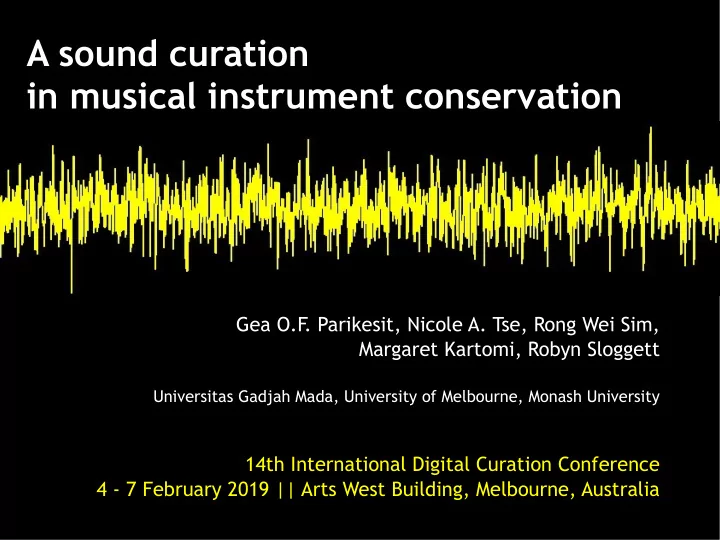

A sound curation in musical instrument conservation Gea O.F . Parikesit, Nicole A. Tse, Rong Wei Sim, Margaret Kartomi, Robyn Sloggett Universitas Gadjah Mada, University of Melbourne, Monash University 14th International Digital Curation Conference 4 - 7 February 2019 || Arts West Building, Melbourne, Australia
The Grimwade Centre for Cultural Materials Conservation Faculty of Arts The University of Melbourne Faculty of Engineering Universitas Gadjah Mada Indonesia The Music Archive of Monash University Faculty of Arts Monash University
Our collaboration began with the bundengan.
Sound characterization of the bundengan.
Sound characterization of the bundengan.
Sound characterization of the bundengan.
Sound characterization of the bundengan.
Next: other instruments also needs to be conserved.
Repair needs to be done with the correct materials and coloring.
This one, called sompoton, has been repaired... But would it still generate the correct sound?
This one, called sompoton, has been repaired... But would it still generate the correct sound? We cannot play it because it is too fragile. How can we know their sound... without playing them?
Here is an idea... All musical instruments are acoustical resonators, with their own natural frequencies. We can feed various frequencies and detect which frequencies resonates with that instrument.
How it works: Input INPUT Frequency x Resonator ? RESONATOR Frequency = Output Frequency OUTPUT = Input x Resonator
How it works: Input INPUT Frequency x Resonator ? RESONATOR Frequency = Output Frequency OUTPUT = Input x Resonator
How it works: Input INPUT Frequency x Resonator ? RESONATOR Frequency = Output Frequency OUTPUT = Input x Resonator
How it works: Input INPUT Frequency x Resonator RESONATOR Frequency = Output Frequency OUTPUT = Input x Resonator
Experimental setup Laptop Speaker Resonator Recorder
Validation: We used a 'Helmholtz resonator' to test our method. Measurement: 430 Hz +/- 40 Hz Calculation: 408 Hz
Experimental result
Experimental result Bb/B D/Eb G G#/A F/Gb G G# A/Bb F Eb/E
Experimental result Bb/B D/Eb G G#/A F/Gb G G# A/Bb F Eb/E
Experimental result Bb/B D/Eb G G#/A F/Gb G G# A/Bb F Eb/E
With this method, we can listen to the instruments without playing them
With this method, we can listen to the instruments without playing them ● New digital data ● Better (?) curation of musical instruments ● New challenges
Thank You
Recommend
More recommend